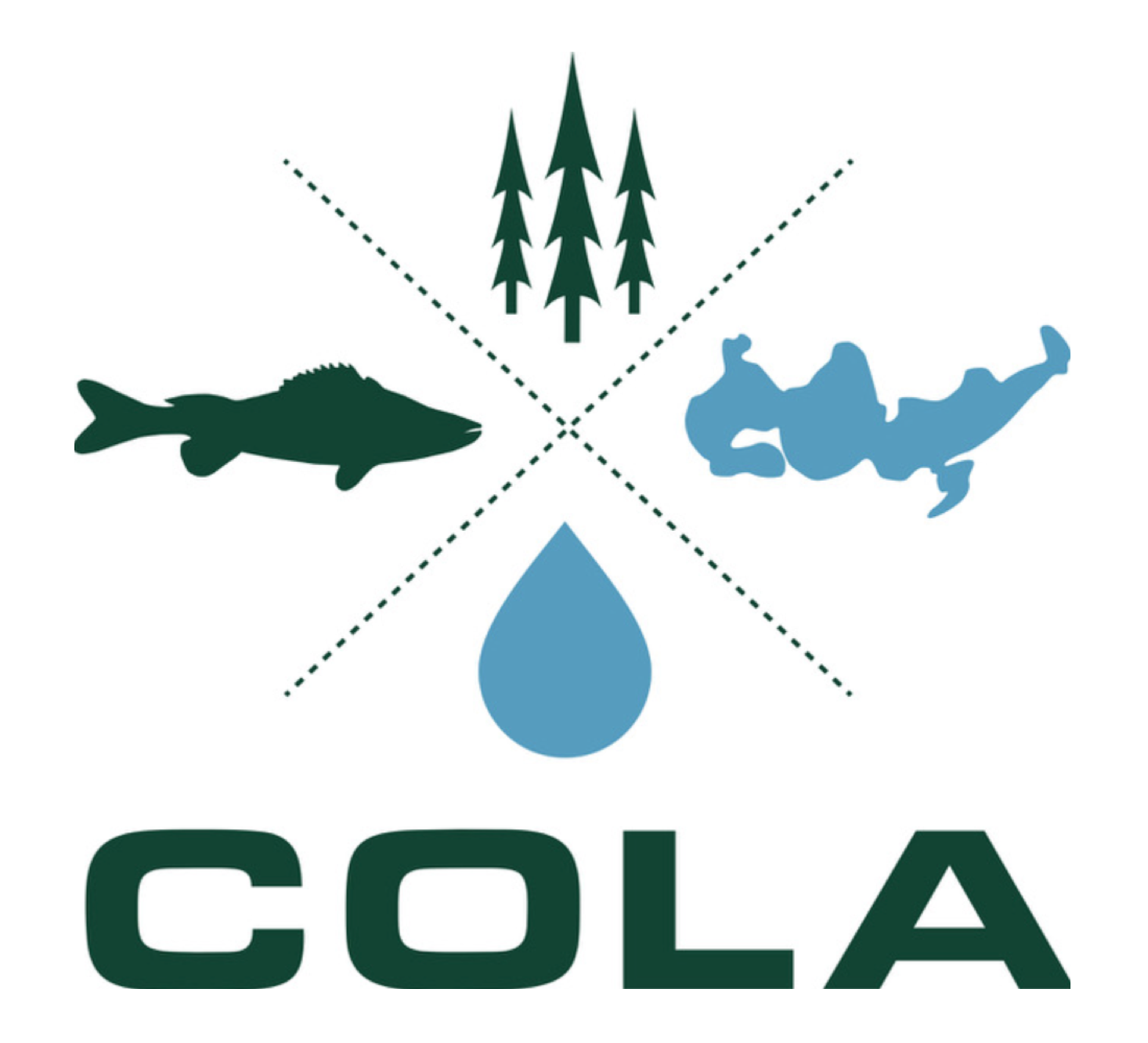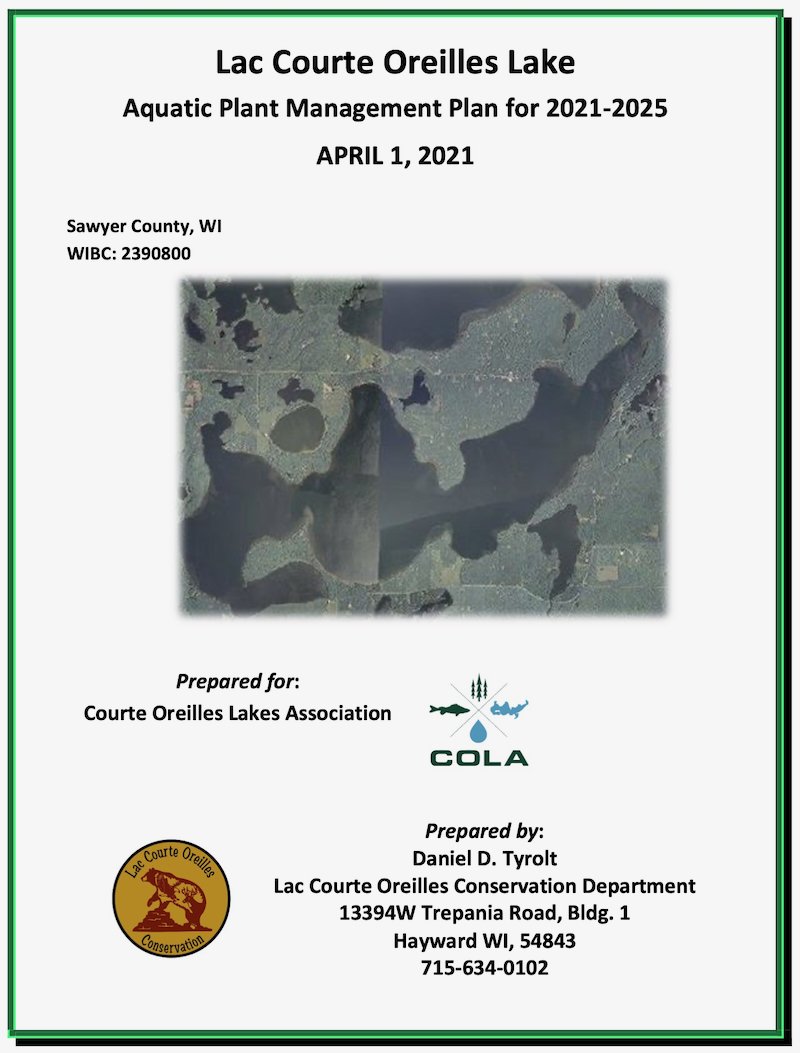Invasive Species
Two invasive species are now firmly established in the LCO lakes, curly-leaf pondweed and Eurasian watermilfoil. Invasive aquatic plant species are nearly impossible to eradicate once introduced to lakes and streams. They were probably brought to LCO by boats from infested lakes, and their exuberant growth has been fueled by excessive phosphorus concentrations in LCO’s water. Unfortunately, both invasive species are easily distributed throughout the LCO lakes by plant fragments scattered by boat traffic. These invasives grow rapidly to form large mats that limit boat navigation and alter the fishery habitat. Late in the season, the invasive plants die back, settle to the lake bottom and decompose, which adds phosphorus and depresses dissolved oxygen concentrations, further harming the fishery. Of the two invasives, Eurasian watermilfoil is the real beast. It increased rapidly since it was first noticed 2015 and is now distributed throughout both LCO lakes. Despite COLA’s best efforts, its spread is accelerating.
(More on curly-leaf pondweed and Eurasian watermilfoil identification)
What COLA is doing about it
cola receives three grantS from WDNR for AIS management
In mid-February 2023, the Wisconsin Department of Natural Resources (WDNR) awarded COLA a $150,0000 grant for management of Aquatic Invasive Species (AIS) in the LCO lakes for the years 2023 and 2024. Additionally, a $4,000 grant was awarded to fund the Clean Boat/Clean Water boat launch inspections, along with a $1,400 grant for video cameras. More details here.
LCO Aquatic Plant Management Plan
COLA initiated its first LCO Aquatic Plant Management Plan in 2011 and updated it in 2021. The updated APM plan identifies the issues and need for management, reviews past management aquatic plant activities and presents management options. By evaluating these components and issues, a sound strategy was developed for the management of aquatic plants in the lake, which includes the following goals: 1) control existing populations of AIS; 2) prevent the introduction and spread of aquatic invasive species; 3) preserve the lakes’ diverse native plant communities; 4) help lake residents to become more aware of the importance of native aquatic plants, the means to protect them, and the threat of aquatic invasive species; 5) restore and preserve native shoreline vegetation; and 6) encourage waterfront residents to minimize runoff of pollutants from their lake property.
Control Introduction of New Invasives
Three public boat landings on Lac Courte Oreilles assist the public in launching and retrieving their boats all summer long: Victory Heights (Town of Sand Lake) in the west basin; Anchor Bay (Town of Bass Lake) in the east basin; and the WDNR ramp in Chicago Bay in the central basin. The Victory Heights and Anchor Bay ramps serve the immediate neighborhoods and are primarily used by the local populations, while the WDNR Chicago Bay ramp is used by lake visitors—and that is why COLA monitors it for aquatic invasive species. COLA has long employed boat monitors to inspect boats coming to and leaving LCO at the DNR landing in Chicago Bay. In 2022, COLA installed the Internet Landing Installed Device Sensor (I-LIDS) at the Hwy K ramp. I-LIDS is a real-time video inspection system for boats. If successful, the system may be used at other landings.
Map and Remove invasive Aquatic Plants
COLA was able to control curly-leaf pondweed in the years shortly after its arrival in 2006 using the Eco-Harvester, herbicides when permitted, and some hand-pulling where appropriate. Unfortunately, Eurasian watermilfoil arrived in 2015, and it has nearly overwhelmed COLA’s capacity to manage both species. The current Eco-Harvester operation is somewhat effective, but the increasing scope of the problem is alarming.
Apply Safe, Effective, Well-Targeted Herbicides
COLA and the LCO Conservation Department have effectively used well-targeted herbicides in the past for both curly-leaf pondweed and Eurasian watermilfoil. In 2023, the permitting process was especially difficult, due to issues with the WDNR. Since many of our 2023 AIS treatments were thwarted, the entire plan was not completed. A full report on our treatment results will be disseminated in the spring when the data is processed. However, COLA is already working toward the 2024 AIS treatment plan. Read “Fighting the good fight” A Summer 2023 Committee Actions Report in Short Ears, Long Tales here>
Eliminate Excessive Nutrients in LCO’s Water
Phosphorus reduction is essential, especially from the discharges from the cranberry marshes on LCO’s shores. Property owners are encouraged to carefully monitor their septic systems, provide shoreland buffers, and limit impervious surfaces. COLA and the LCO Tribe have been working with the WDNR since 2016 to establish a lower phosphorus standard, termed a “Site Specific Criterion” (SSC), for the LCO lakes (excluding Musky Bay). The site-specific criterion (SSC) of 10 μg/L for phosphorus for Lac Courte Oreilles was finally approved by the Wisconsin State Legislature following the recommendation of WDNR’s Natural Resources Board and Governor Evers.
This is a tremendous victory for Lac Courte Oreilles.
A huge challenge remains. The new 10 μg/L phosphorus standard can only be reached by voluntary actions because all sources of phosphorus on LCO are currently regarded as “non-point” under the Clean Water Act. This means that there are no regulatory measures available under federal or state law to control phosphorus pollution.
More than 40% of the readily-controllable phosphorus is coming from the cranberry marshes on LCO. The discharges from the marshes can be cleaned up by recycling water by the use of holding ponds. COLA, the LCO Tribe, and the WDNR will renew efforts to bring the cranberry growers into an alliance dedicated to reducing phosphorus pollution.
More …
Lac Courte Oreilles Aquatic Invasive Species Lake Monitoring Training Manual
Available here.
REMOVING EURASIAN wATERMILFOIL AROUND DOCKS AND IN SHALLOW PARTS OF YOUR SHORELINE
Lac Courte Oreilles & Little Lac Courte Oreilles 2023 Aquatic Plant Survey Report
Aquatic invasive species (AIS) continue to be a problem, of particular concern are curly-leaf pondweed and Eurasian watermilfoil on both Lac Courte Oreilles and Little Lac Courte Oreilles. In 2023, we conducted an aquatic plant survey focusing on AIS for each lake. The complete report is available here.
2023 AIS Mapped locations
Available here.
How can you help?
Please support COLA’s Clean Boat Initiative by routinely inspecting all of your watercraft for AIS. If you have the time, please join COLA’s AIS or Eco-Harvester work groups to help identify and remove AIS.
Learn more
"Clean Your Boat: Learn about Invasive Species" - https://www.seattleyachts.com/clean-your-boat-learn-about-invasive-species
Related Stories in Short Ears, Long Tales
Issue 22 'Lac Courte Oreilles Boat Landings'
Issue 39 ‘A Short Lesson on the Ecology of Two Invasive Plants’
Issue 40 ‘Protecting the Lakes: Aquatic Invasive Species Mapping and Management’
Issue 47 ‘The Early Voyages of the Eco-Harvester’
Issue 48 ‘Invasive Mystery Snails’
Issue 50 ‘Milfoil(ed) Again’
Issue 52 ‘Tales of Two Plants’
Issue 57 ‘Aquatic Invasive Species - What Happened in 2022’












